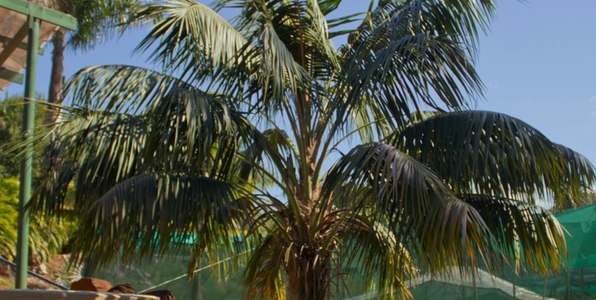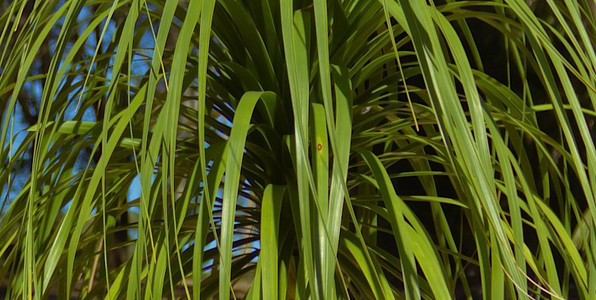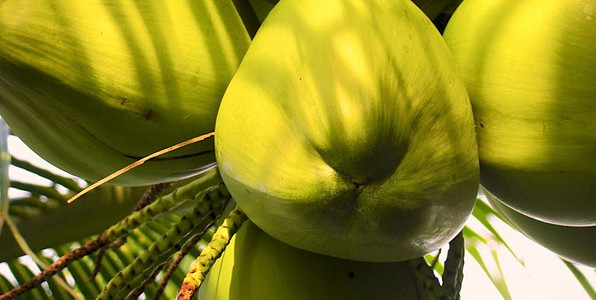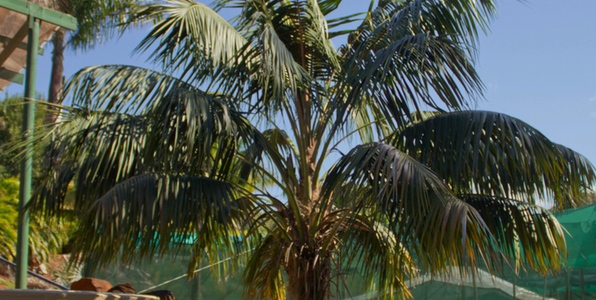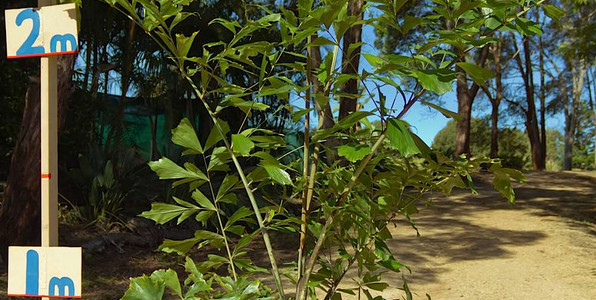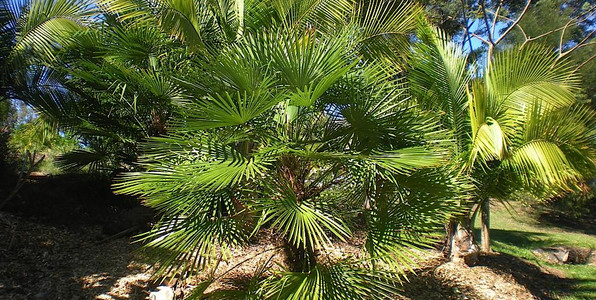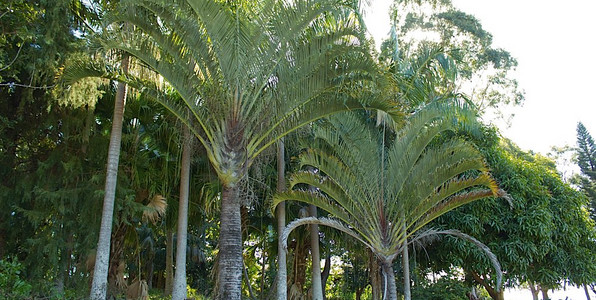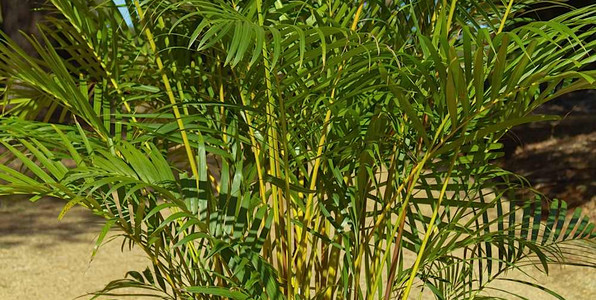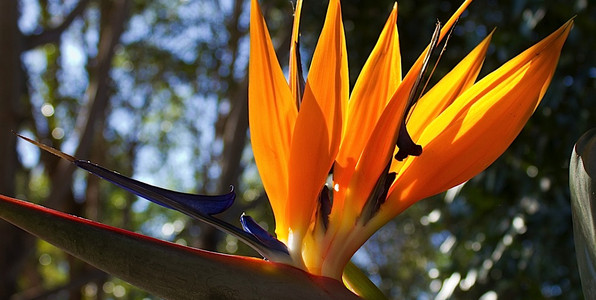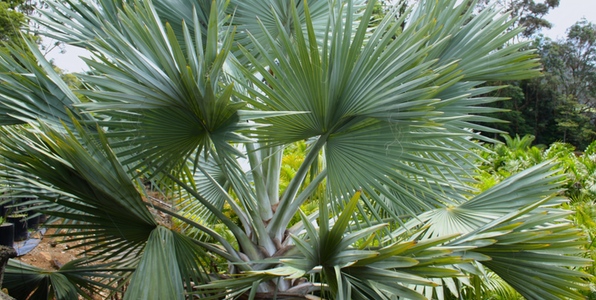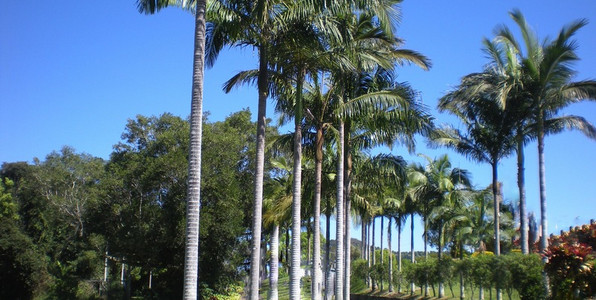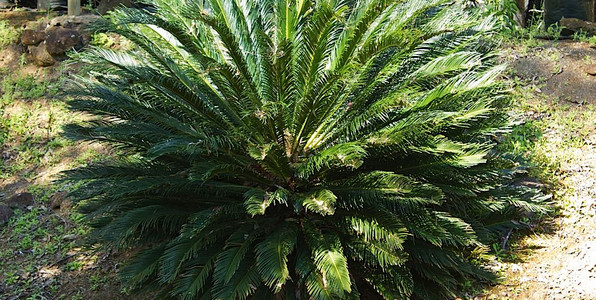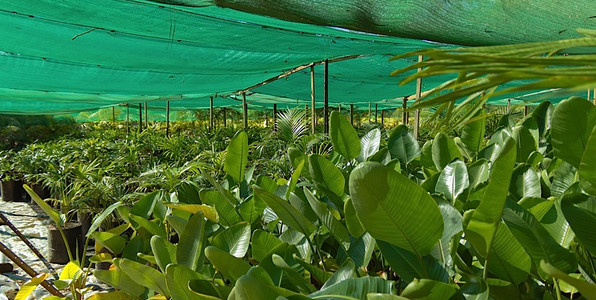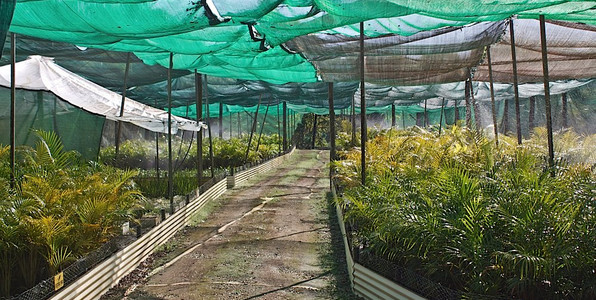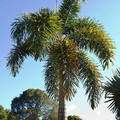Jump to page
Palms:Sun, Water and Soil
Sunlight
Some palms prefer to be under the shade while others welcome the heat. Palms like the Alexandra and the Foxtail like full sun from early age but do well in either condition. Cascades (Chamaedorea cataractarum) and Australia Fans (Licularis ramsayi) like some shade while Kentia's (Howea forsteriana) take time to adjust.
If you're planning to grow palms indoors, check for the types that do well with little sun exposure and can tolerate air-conditioning. The Kentia does well in these environments and can even withstand a little neglect, as do Lady Palms (Rhapis excelsa). Indoor palms benefit from being taken outside every few weeks to receive full sun in order to regain strength.
A guide to potting, planting and caring for your palm tree
Potting palms to some is an easy task. However, when dealing with such an intricate plant, it is important to have a set of steps to ensure optimal growth. The most important part of potting a palm is to know what species it comes from, the conditions that it requires for growth, and the level of maintenance needed to keep it healthy.
Certain aspects such as pot types, soil mixes, watering and fertilization, affect the patterns of growth of a palm, below is a guide to potting.
Palm Fertilizer and Best Practices
Palms achieve their best condition when they are taken care of properly. Likewise, they also appear their best when receive sufficient attention. It is important to learn the fundamentals of palm care to be able to bring out their ultimate capacities. One way to bring out the best in palms is through the use fertilizers. Fertilizers help enhance growth and make it possible for the plants to reach optimal condition.
Nonetheless, it is essential to understand that while fertilizers are generally good for palms they can also be damaging if not applied properly. There are general procedures for applying fertilizer regardless of the plant type. However, it will also do the grower well if they can learn more about fertilization application specific to their species.
Palm Pollination in a Nutshell
Pollination is how most, if not all plants and flowers propagate. It is essential in making sure that the world's foliage is able to maintain the delicate balance of the eco system.
Palms also undergo the same process of propagation. Palms are plants that flower enabling them to reproduce through the pollen of the flowers. Different palms have different flowers and vary in appearance and size but the basic procedure is relatively similar for all. Palms produce flowers at different times in their life span, depending on the variety. Some palms flower very rarely and some more frequently. There are even palms that flower near the end of their life like the Fishtail Palms. In this case, the optimum time in which pollination should happen differs from palm to palm.
Palms: Solving Brown Tips and Leaf Problems
Planted palms are generally very easy to maintain. They require little effort and only sufficient tender loving care. Some things to take care of include soil condition, leaf problems and brown tips.
Natural Browning
Before trying to solve browning in palms it is important to understand why palms go through a browning process. Basically, browning tips are natural. Palms produce new leaves throughout their growing period. As the plant reaches the end of its growth or life, its tips will start browning until it completely dries and then drops from the body of the plant. However, there are instances wherein browning is not just a natural occurrence.
Madagascar, an Island of Palms
Madagascar is a "garden of Eden" for bio-diversity. It is home to 10,000 plant species, 90% are found nowhere else in the world. It is the 4th largest island in the world, situated off the east coast of Africa slightly below the equator. In Australia the same latitude is from just above Brisbane to Cape York .It is 1580 km's long and 570 km's wide and has 6 different microclimates. The highest mountain is 2876 metres and a steep mountain range parallels the entire east coast.
Madagascar broke off from Gondwana 160 million years ago and then broke away from India 80 million years ago. It has an eastern and south-central rainforest area, a western dry forests area and a southern desert area.
Common Palm Diseases and How to Treat Them
Palms are beautiful plants that flower and produce gorgeous shades of yellow to green fronds. Australia is home to over fifty known species of palms, flourishing in its tropical and sub-tropical areas.
Despite the natural climate and environment that are perfect for their nurture and growth, palms aren't free from a number of diseases. Below are the types of diseases that Australian palms are particularly susceptible to and how to treat them.
Palm Pests and Applying Proper Extermination Techniques
Although palms are a very attractive addition to any garden or lawn space, some care and maintenance must go their upkeep. If you want to hang on to the lush tropical and exotic feel that these palms bring, be aware of the different pests.
There are many known types of pests and insects that hasten or slow down the growth of palm if not completely killing them. Generally if a palm is healthy with normal water and food, pests will not do serious harm.
Here is a list of some of the most well known types of pests that are particularly fond of palms in Australia:
SUGAR CANE WEVIL BORER
This insect was in nth QLD but is now in southern QLD and nth NSW.
The grub eats holes into the base of the palm trunk at about ground level, eventually killing your palms. This grub is about 2 cms long and 6 mm wide with a white body.
The adult is gun barrel grey and is often nearby, best way to kill it is with a systemic insecticide , household fly will do if applied to the insect or into its hole.
The sugar cane borer lives in old established palms where the fronds meet the trunk and does no harm to such a big trunk. Unfortunately the adult may infect nearby your palms, especially if they are under stress.
The borer is most active over summer and likes Golden Canes, Bangalows, Kentias, Foxtails and Kentias best. I have never seen it attack some cold palms like Chamerops humilis, Cascades, Rhapis, rarely Solitares
This borer is smaller than the Giant Palms Borer but is just as much of a problem. If a young palms dies and you notice the white grub then destroy the dead palm, the smell of the infestation attracts the adult again also grubs will be inside the trunk , clean excess dead fronds from surrounding palms, spray the lower trunk with a systemic insecticide or just
a surface household insecticide then check for borer holes or grubs in the coming weeks say 4 to 6 The life cycle is something like this but if there are old palm trees nearby within 10 metres then the palms may become re infested.
Eventually the palms are too old for the borer to harm , sometimes a 2 metre palm in full sun with a trunk width of 10 cms is safe. But other times the borer will damage large Kentias and Foxtails at 8 metres tall plus
Giant Palm Borer
The Giant Palm Borer is a large beetle that is quite unattractive to look at. Its larvae are quite fond of palms in the Australian region. These borer grubs can actually exist inside a palm trunk for a period extending up to nine years. They develop into full-grown beetles within that time and exit through holes in the palm trunk.
When a borer infestation goes out of control or reaches a maximum, they can weaken the structure of even the sturdiest palm. It is best to watch out for an infestation during the early stage.
Unfortunately, there isn't much you can do to combat an infestation of the Giant Palm Borer. Since the growth happens inside, you won't be able to tell whether your palm is holding a family of beetle pests or not. Usually, it is too late once you do find out, when they have already exited your palm and done the damage.
The best thing you can do is to prevent the infestation from happening in the first place. Keep your palms properly cared for and maintained to lessen the chances of a Giant Palm Borer attack.
Palm Budworm
This type of pest is also from the family of beetles. Its larvae like to feed on the flowers of different types of palms. The worms are about an inch in length and have shades of pink and green. The moths are a murky brown and characterized by a dark spot on each wing.
Although Budworms are not particularly dangerous to the life of your palms, they can still be quite annoying to have around. Very intense infestations of the budworm may also cause the structure of your palm to weaken considerably.
To exterminate the pests from your palms you can contact your local forestry office or specialist. There are some brands of chemicals that can effectively rid your plans of these insects. Make sure to follow instructions carefully to keep you and your plants safe.
Royal Palm Bug
This little critter has a particular taste for palms. In fact, it is the only thing that it feeds on. Once it has settled in the leaves of a palm, it lays one egg a day, for the whole of spring. The egg is protected by the palm leaves until they are ready to hatch.
After about nine days, the eggs hatch producing new bugs that proceed to munch on the leaves, causing them to yellow. When there are extreme numbers of bugs chewing on one leaf, it will turn brown and eventually wilt.
It does not really cause extensive damage to the palms but having them around may lead to unsightly looking palm leaves. As full-grown palms can be considerably hard to reach, Royal Palm Bugs are a challenge to exterminate.
To exterminate royal palm bugs spray them with insecticide. This may pose a problem since these pests are not known to attack palms that are less than 4 metres in height. In that case, you may need a ladder for direct application. Another solution to try is imidacloprid (Merit), which you can apply to the base system and roots of your palms.
These are just some of the pests that may inhabit your palms. If you do not perform routine checks, you may end up losing your beautiful palms to these pesky parasites.
Factors to Consider in Choosing the Right Palm
Warm or Cold?
The prevailing climate of your area will determine the limitations of your palm list. If you live in a warm to tropical region, you can cultivate most palm varieties. Since palms are endemic to tropical places, these can very well adapt to your place.
However, if you love palms but live in a place with cooler temperature especially during the winter months, choose cold hardy palms instead. There is quite a list of these palms that can be found online as well as tips on how to care for them. Some examples are Chinese windmill (Tracarpis fortunei), Cocos (Syagrus romanzoffiana), WineButia capitata), European Fan Chamerops humilis), Lady Palm (Rhapis excelsa)
The Do's and Don'ts of Palm Pruning
The interesting thing about palms is that they are not often pruned or trimmed. They are actually known as monocots. Essentially, that means they don't grow outward in their trunks the way typical trees do. This is why it is essential that care be properly taken when pruning or trimming.
Palms grow one leaf at a time. Clearly, this slow process requires some thought and planning before running at your palm with a pair of pruners. Not using proper techniques and guidelines could kill your palm.
Protecting the Australian Environment
Branded the "island continent", Australia is known for its beautiful and varying landscapes. From the deep, blue waters that house the Great Barrier Reef, the world's largest reef system, through the 60 million year old wilderness of the Tropical Rainforest, to the dramatic cliffs and canyons of the Blue Mountains, Australia is home to vastly different manifestations of nature.
However, with all of the beauty of what is seen as Mother Nature's canvas, there comes great responsibility for its care. Hostile species, such as certain types of birds, weeds, and bugs are a grave threat to the Australian landscape.
Speak the Language of Palms. A Vocabulary Guide for Gardeners
It is very important that you familiarise yourself with the most commonly used terms for growing palms. Otherwise you will have a hard time articulating what you want to buy for your palms and how to maintain their health.
Here is a list of the most commonly used terms when growing and caring for palms.
Some of the Common Naturally Occurring Australian Palm Trees
| Alexandra palm: | Archontophoenix alexandrae comes from the QLD coast to Cape York and grows to 30m. | |
| Atherton palm: | Laccospadix australasica comes from the Atherton Tablelands and grows to 8m.: | |
| Australian Arenga: | Arenga australasica comes from Cape York and the top of the NT coastand grows to 20m. | |
| Australian Fan palm: | Licuala ramsayi comes from the rainforests of north QLD and grows to 20m. | |
| Bangalow palm: | Archontophoenix cunninghamiana comes from the Irrawarra to Mackay and grows to 25m. | |
| Black palm: | Normanya normanbyi comes from Cairns to Port Douglas and grows to 20m. | |
| Cabbage palm: | Livistona Australis comes from the Fraser Is coast to the eastern Victorian coast. | |
| Carpentaria palm: | Carpentaria acuminate comes from the top of NT and grows to 30m. | |
| Coconut palm: | Cocos nucifera comes from Fraser Is to Cape York and grows to 35m. | |
| Curly palm: | Howea belmoreana comes from Lord Howe Is off NSW and grows to12m. | |
| Darwin palm, : | Ptychosperma bleeseri comes from around Darwin and grows to 12m. | |
| Dwarf Fan palm: | Livistona muelleri comes from inland north QLD and grows to 6m. | |
| Fan palm: | Livistona benthamii comes from the top of NT, Cape York and New Guinea and grows to 20m. | |
| Fishtail palm: | Caryota albertii comes from Cape York and grows to 20m. | |
| Foxtail palm: | Wodyetia bifurgata comes from far north QLD and grows to 20m. | |
| Florence Falls palm: | Hydriastele wendlandiana comes from the top of the NT and Cape York and grows to 15m. | |
| Gebang palm: | Coypha utan comes from the top of NT and Cape York and grows to 25m. | |
| Kentia palm: | Howea forsteriana comes from Lord Howe Is and grows to 15m. | |
| Macarthur palm | Ptychosperma macarthurii comes from around Darwin and Cape York and grows to 8m. | |
| Mataranka palm: | Livistona rigids comes from the Lawn Hill National Park and Mataranka in the NT and grows to 20m. | |
| Mt. Lewis: | Archontopoenix purpurea comes from Mt Lewis north QLD. It’s a close relative of the Alexandra and grows to 6 to 8m. | |
| Norfolk Island Palm: | Rhopalostylis baueri comes from Norfolk Is and grows to 16m. | |
| Ribbon Fan palm: | Livistona decipiens is found in pockets along the coast of QLD and grows to 15m. | |
| Red Cabbage palm: | Livistona mariae comes from around Alice Springs and grows to 20m. | |
| Sand palm: | Livistona humilis comes from the top of the NT and grows to 6m. | |
| Solitare palm: | Ptychospermia elegans comes from Noosa Heads and up the coast of QLD and grows to 15m. | |
| Umbrella palm: | Hedyscepe canterburyana comes from Lord Howe Is and grows to 10m. | |
| Walking Stick palm: | Linospedix monostachya comes from the subtropical rainforests and grows to 2 to 3 m.: | |
Playing Horticultural Cupid: The In's and Out's of Pollination
Pollination, which may be loosely defined as the depositing of pollen to ensure plant fertilization, is a crucial factor in the growth and wholesale of plants in Australia. However, due to several unique geological qualities, as well as the presence of unique wildlife, the entire process has become somewhat more complex. These reasons will be explored shortly in the article to follow.
Geological stability is the defining factor of Australia's unique fauna and flora. Unlike neighbouring New Zealand, which was shaped by massive geological upheavals, geologists estimate that the geological make up of the continent has remained the same for approximately 80 million years. This unparalleled stability has led to very distinctive soil types, which in turn has allowed for the growth and development of some of the world's most amazing plant life.
In directly causal fashion, animals developed alongside these special plants to take advantage of the food on offer. Australia is world renowned for one-of-a-kind animals, from kangaroos to koalas. And these animals are, in general, responsible for pollination of plants. Although it is true that some plants have developed bisexual methods of what is essentially self-pollination, the animal vectors are the favored reproductive strategies for most plants.
Whilst all of this localized diversity is a pleasure to Australian residents and a source of national pride, it has undoubtedly led to issues regarding the pollination of plants, particularly in the commercial sector. While new developments in the engineering of customized hybrid plants have led to some beautiful new flowers, the natural role of flowers in particular has diminished.
Flowers serve as advertisements to potential pollinators. As a reward for their visiting the flower, they would receive pollen and nectar. However, engineered plants lack the rewards that natural plants offer, and so potential pollinators are not as attracted. Once again, the domino effect of such a problem is fairly self-evident - no pollinators leads to no new pollination, which leads to diminished growth patterns and ultimately, extinction of the species of plant and insect.
Another area of concern, particularly in Australia, is the decreasing number of certain key bat and bird species. Birds in particular spread seed over vast distances via their droppings, allowing plant species to reach out over larger geographical sights. Bats spread seed in much the same way, as they are attracted to very specific, strong-smelling plants which flower at night.
Their droppings help to spread the seed of such plants. However, increasing areas of destruction for agriculture and housing lead to the elimination of these types of plants. Several animals, such as possums and specific kinds of beetles native to Australia, are facing extinction as their habitat shrinks on a daily basis.
In much the same way as the genetic flower hybrids are leading to a subtle slowing in the efficacy of certain key pollinators, widespread destruction of key ecosystems is literally forcing pollinators to adapt to new conditions which they simply cannot cope with.
The situation does indeed seem dire. Unique geological conditions have given rise to native animals with highly evolved pollination strategies, but due to human ingenuity and simultaneous carelessness, this balance is being threatened.
Studies in Argentina, America and England have suggested that the life cycle of bees has been affected by similar issues to the point where their numbers have decreased by as much as 50% in just 20 years. Feral honeybees (Apis mellifera) are threatening native bees, which has a direct and severe impact on plant pollination.
There is hope for the future if commercial plant dealers and farming communities co-operate with government in order to try and slow these worrying trends. Australia is recognized for forward thinking regarding the preservation of local flora and fauna via botanical gardens and reserves, but this pride needs to be instilled in every citizen.
Legislation to protect larger plants such as palms also needs to be passed to ensure that some of Australia's amazingly well-adapted wildlife will always have a home. And commercial plant dealers may have to take a step back with genetic development and do things the traditional way - pollinating plants themselves until nature's pollinators are able to do the job themselves.
Something as simple as a paintbrush may be used to ensure successful reproduction of plants. In an industry that is proudly selling natural, indigenous plants and products, many believe that a simple return to traditional techniques will help Australia to correct its natural balance and continue to prosper and grow as a bastion of flora and fauna.
Ways to Enforce Weed Control and Keep Your Palm Safe
Most palms are relatively easy to maintain. But like most plants, weed growth is a prevalent and annoying problem. It may seem like no matter how often you take the time to pull weeds out in your garden, they always grow back and flourish.
Weeds are basically just like the plants that you're caring for in your garden. They need the same basic things just like any palms and other plants: sunlight, water and nutrition. As long as they have everything they need, best believe that they will keep on thriving.
Useful Tips on How to Properly Move Large Palms
In the case of gardening, there will be instances when you must move your palms in the ground. The reasons are plenty. You may need to make more space; you may need to improve the spacing between them for better growth or you have just decided that it is more aesthetically pleasing that way. Whatever your reason for transplanting your palm, you must follow some basic instructions.
Luckily palms are one of the easiest plants to move because of their large and fibrous root ball as opposed to trees with long taproots. They are compact and may be lifted out like a ball. The palms are also known for recovering quickly after a move.
During the growing season is the best time. Take as much soil as possible around the root ball. Some palms will not survive moving such as the Bisimarkia's and Bangalow's. Alexandra's are good to move along with Windmills, Golden Canes and Triangles.
Consider the location where you will be moving your palm
Take into consideration the size the palm might grow into and if the view will be compromised.
Prune any damaged or worn out fronds and water the palm's roots thoroughly right before you plan the move.
Start digging a trench around the palm
Once the trench is deep enough, dig out as large a root ball as you can manage. Push the plant gently until it has tipped over. With the help of a crowbar and shovel, pry out the rest of its root system until you get it completely out of the hole. It is inevitable to cut into some of the roots.
You may need up to three or four people to help you lift out the palm from the hole depending on the size. It will be handy to have a wheelbarrow or a cart for easy transportation. If the palm is large and you have the money, employ a small or large excavator.
Wrap the roots of your Palm
If the transplanted palm involves moving via a vehicle, it is important to wrap the roots in hessian cloth. Spray the hessian with water to ensure that the roots stay most while in transit. Bring together all the palm fronds and wrap them together using twine.
Water the hole well
Before planting the palm into its new location, make sure that the new hole is watered. Place the palm into the hole at the same depth as it was growing before. Add water to the hole after you have planted it. Then pack soil around the palm tightly. If the palm is tall (4 metres or more) tie up the fronds around the palm trunk when re planting the palm. Leave them tied for a couple weeks after re planting. This will reduce transpiration and reduce the palm moving in the wind. The palm's roots need to re connect and grow back into the soil. To also assist with root re growth , compact the soil around the base of the re planted palm. Even better with large and expensive palms use a commercial soil compactor to compress the soil. Establish a drip watering system at the base of the palm and leave it running for the first couple weeks.
Build a stake using three posts to keep the tree in place and secure
You can use metal star pickets or stakes made out of timber. Use your hessian tape to keep them in place.
Keep the soil moist
Remember to water daily to keep the soil moist and to help its roots establish themselves in their new location. Water the roots with a seaweed solution this will help promote root development. It will take about three weeks before you can cut down on watering to about twice or thrice a week depending on the temperature. Once you have stabilized your palm into its new place, you may begin to fertilize.
How to Identify Other People's Australian Palms
There are over 25000 species of palms in tropical, subtropical, and warm temperate climates around the world. Over 50 of these are found in Australia. These flowering plants are usually characterized by an un-branched stem (there are some exceptions) and large leaves (fronds) arranged around the top. They are extensively cultivated and widely used in landscaping due to their exotic appearance.
There are two main types of palms, palmate and pinnate. Palmate palms have large, fan-like fronds, while pinnate palms have fronds that resemble feathers. Both types of leaves are usually spirally arranged at the top of the stem, and the flowers are usually small and mature into a single-seeded fruit. While many species of palms are sold and can grow in Australia, we are going to focus on some of the more common native species:
Alexandra Palm (Archontophoenix Alexandrae)
This palm is a native along the coast of Queensland and the tip of the Cape York Peninsula. It can grow up to 30 metres, but is significantly smaller when raised in a garden. It has a pale green crown shaft and a grey to greenish-grey trunk. Its fronds are 2 to 3 metres long, with white flowers and red fruits.
Australian Cabbage Palm (Livistona Australis)
This is a popular landscaping palm due to its tolerance to various weather conditions, including frost. It is found on the eastern coast of Australia and grows up to 30 metres tall. It features a grey trunk; palmate leaves approximately 3 metres long, yellow flowers, and reddish-brown fruits.
Australian Fan Palm or Wedge Leaflet Fan (Licuala ramsayi)
This is an amazing understory rainforest palm from nth QLD where they grow to 15 metres. They will also grow south into northern NSW and can be grown further as an indoor plant. They are slow growing and need moisture and warmth. Worth the effort if you can grow one.
Bangalow Palm (Archontophoenix cunninghamiana)
This palm is very similar to an Alexandra but the trunk is thinner and the colour under the leaves is green the same as on top of the leaves .It grows to 25 metres. The Alexandra has a more silvery colour on the underside. The Bangalow is cold tolerant and ok for Melbourne, the Alex is not. They will cross pollinate if they are flowering together producing " Albangs or Bangalex's"
Black Palm (Normanya normanbyi)
This palm grows about 20 metres tall and is found in the North Queensland rainforest. It has a grey crown shaft and a light grey, smooth and slender trunk that turns almost black as the palm ages. It has 3 metre, pinnate fronds, white flowers, and yellow fruit.
Carpenteria Palm (Carpentaria acuminate)
This palm is found in the Northern Territory. It is a tall (30 metres), solitary palm that can reach maturity in 6 years under the right conditions. It has a grayish-green crown shaft and 4 metre long, dark green, pinnate, re-curved fronds. It features white and scarlet flowers.
Coconut Palm (Cocos nucifera)
This palm features a large palm head and massive coconut fruits. It is native to Queensland and tropical areas of the Western Pacific and can grow to be 35 metres tall. It has a grey trunk, cream flowers, and pinnate fronds.
Fan Palm (Livistona muelleri)
This palm grows to approximately 16 to 25 metres, but remains much smaller in gardens (3 to 4 metres). It is native to the Northern Territory and the Cape York Peninsula. It has a brown trunk, bluish-black fruit, and large, palmate fronds.
Fishtail Palm (Caryota albertii)
This palm is a large, clumping palm that grows to be 5 to 10 metres tall and approximately 4 metres across. It has a light green to grey trunk, bi-pinnate fronds with widely spaced leaf nodes, cream flowers, and dark purple fruit. Its natural habitat is the Cape York Peninsula.
Florence Falls Palm (Hydriastele wendlandiana)
This palm grows 7 to 20 metres tall in the top end of the Northern Territory and the eastern coast of the Cape York Peninsula. It has a whitish-green crown shaft and clusters of 2 to 3 slender stems rising above a dense cluster of cane-like stems. The fronds are broadly pinnate, and it has red fruits on short stalks located below the crown.
Foxtail Palm (Wodyetia bifurgata)
This palm is native to Queensland. It is suitable for tropic, subtropics, and temperate areas. It is a single trunk palm that grows to 15 metres with a pale green crown shaft and pinnate leaves. It features feathery white flowers and large bright orange fruit.
The leaves are surated at the tips and along with the arching frond, look like a foxes tail
Kentia Palm (Howea forsteriana)
This palm is native to Lord Howe Island. It is a solitary, medium-sized (up to 15 metres) palm with brown flowers and orange to red fruit. It has a brownish-grey trunk and large fronds.
Solitaire Palm (Ptychospermia elegans)
This palm grows up to 10 to 12 metres and is found in Queensland. It has a green crown shaft and a greenish-grey stem. It has a head of semi-erect, pinnate fronds and produces white flowers and bright red fruit.
Umbrella Palm (Hedyscepe canterburyana)
This palm grows up to 10 metres tall with a 1-metre long, silvery crown shaft. It has a grayish-green trunk, 3-metre long re-curved fronds, and orange to yellow flowers. Umbrella Palms also feature deep red fruits that are 4 centimeters long and densely bunched below the crown shaft.
The Basics of the Ponytail Palm (Beaucarnea recurvata)
Ponytail Palms may look quirky and amusing but this plant is on track to being one of the most popular varieties of garden and indoor palms. It is not a true palm.
The Ponytail Palm is characterized by its 6 inches long and 1 inch wide leaves that look like ribbons emerging like a fountain from the branches in a downward curl making it look like an onion. It has a very graceful appearance, making it a favourite among landscapers and gardening enthusiasts. When it eventually flowers and seeds the seed head is a spectacular pinkish colour.
Palm Delicacies - What Palm Fruits are Good to Eat
Humans have cultivated and used palms from the beginning of civilization. Date palms, for example, have been used by the middle-eastern settlements for over 5000 years. Other uses of palms include the harvesting or extraction of coconut, oils, syrups, ivory nuts, carnauba wax, rattan cane, raffia, and palm wood.
Other varieties of palms also provide, betel nut, heart of palm (used as a vegetable), nypa (a sap used to make vinegar), dragon's blood (a reddish resin which is used in the manufacture of medicines, varnish, and dyes), coir (which is a fiber that is comes from the shell of coconuts and has a multitude of applications), sago, palm wine (made from Jubaea or Chilean wine palm), and a host of other uses.
Growing Wine Palms (Butia capitata)
The Wine palm genus of about eight species come from South America and can be a very good palm to grow in cold parts of Australia. They give lots of benefits and enhance the landscape. Depending on the setting, you can do a lot of things with a wine palm. Below are some aspects and fundamentals of growing wines.
Species Overview
The wine palm is a type of palm that is best known for its thick trunk. In fact, among all palm, the wine palm has the thickest trunk to date. The origin of wine palm goes back to the Andes Mountains then it spread all over the globe. The palm can grow to 20 metres.
The trunk diameter differs from one plant to another and depending on the kind of environment it is exposed to. As for the height of the trunk, remember that it takes years even decades for a palm like this to grow even just beyond the 6 metre mark in cold climates. If you want to grow a large plant, be patient. This is one reason why the wine palm has turned out to be one of the most costly palms around.
In many ways, the purchase of a palm like the wine palm is considered a sign of affluence. Because of its size and the way it grows, people usually treat having a wine palm as a symbol of their prominence. The Wine palm is inclined towards sun and heat but is also suited to the colder parts of Australia. It is the most common Wine grown here. The Butia capitata is named the Wine and Jelly palm because its seeds have fruit around them that are edible and taste like wine and jelly. This plant will tolerate -10 degrees c, grows to 5 metres and is quite drought resistant.
Growing Wines
The Wine seedling should be placed in a small well drained container ( 3" tube), under shade and away from excessive rain or watering. A waterproof greenhouse is best. When it has outgrown this container move it to a larger container ( 8" pot) under shade exposed to rain. When the plant is half a metre with several fronds then it can be planted in the ground during the growing season. Use slow release fertilizer when required.
This type of palm prefers its surroundings to be dry if the temperature is cold, ideal for Adelaide. Additionally, make sure the soil has good draining capabilities. Clay soils can be used if the drainage is OK but the moisture content should be low. In good growing conditions they may become top heavy and lean over while waiting for their root system to anchor the large trunk.
Caring For Your Kentia Palm (Howea forsteriana)
Palms are beautiful additions to any garden or indoor space if you're going for the beach or island vibe. Some palms are more difficult to maintain and care for than the others, but the Kentia Palm is one of the all-time favourites for homeowners and landscapers because of its low-maintenance yet strikingly tropical appearance.
The Kentia Palm has a thin, slender trunk with feather-shaped, drooping fronds. When young, the trunk is dark green and turns to brown as it gets older. The Kentia flowers yearly around November or December
A Beginner's Guide to Fishtail Palm Tree Care (Caryota Genus)
Fishtail palms are found from Cape York through SE Asia to China and India; they grow in rainforests of varying altitudes. The Australian Fishtail (Caryota albertii) is a climber and makes a good indoor palm. The Clustering Fishtail (Caryota mitis) is a spectacular palm for coastal Sydney and above in a protected place. When one trunk dies after seeding (as they do) there are lots more in its place.
Fishtail palms are wonderful additions to any garden or living space that can add a tropical island feel effortlessly. The leaves of the plant have jagged-edges that look like fins and fishtails, hence the name.
Tips about Caring for Majestic Palms (Ravenea rivularis)
Majestic palms (Ravenea rivularis) are characterized by their bright green, symmetrical leaves, untidy crown and slightly swollen base. They are a favourite among landscapers and gardening enthusiasts when they're going for that distinctly tropical island feel. They will tolerate cold to -3 degrees c, shaded areas and other plants towering overhead.
If you are thinking about adding a Majestic palm to your garden, here are some tips that you can review.
Fertilize! Fertilize! Fertilize!
Probably the only maintenance that you will need to do regularly is to apply fertilizer to avoid any nutritional deficiency. You can use a regular palm fertilizer with a 3-1-3 ratio for smaller plants and 15-5-15 ratio for bigger plants of nitrogen, phosphorus and potassium. Be careful when applying the fertilizer and follow the package instructions.
The Highs and Lows of the Bangalow Palm
Palms are beautiful plants that add to any garden or indoor space creating a tropical lifestyle. There is a variety of palms to choose from and each has its highs and lows.
One of the more popular palms in Australia is the Bangalow (Archontopoenix cunninghamiana). The plant has bright green leaves and a thin trunk, making it seem that the leaves are too heavy or big for the trunk below. It provides a comforting canopy and a decent shade against sunlight.
Tips for Growing Chinese Windmill Palms
Most people think of palms as tropical plants, but the Chinese Windmill Palm, which is also known as Chusan Palm (trachycarpus fortunei) proves that palms can also grow in cold-hardy zones. Beginners are likely to have an easy time caring for the Chinese Windmill Palm since it is quite tolerant of many conditions.
This palm is not suited to tropical Australia where it is too warm and wet in the summer. In the subtropics around northern NSW it does most of its growing during winter. Its only problem is too much rainwater during summer, causing fungal diseases. This is the coldest tolerant palm in the World growing down to -15 degrees c.
Understanding the Nature of Triangle Palm for Beginners
The Triangle Palm ( Dypsis decaryi) is one of the more attractive palm species. It is characterized by its meticulously arranged fronds that form the shape of a triangle.
What makes the Triangle Palm so conducive to first time palm planters is that it grows extremely well whether indoors or outdoors. Because of its beautiful and unusual shape, they are a favorite to plant for enthusiasts and hobbyists.
Keeping Your Foxtails Disease Free
The Foxtail is a very durable self-cleaning palm. Its trunk sheds old bark when a strong breeze passes through making it easier for you. Nevertheless, you should still ensure that it has everything it requires in order to avoid diseases and stunted growth.
Avoid harmful caring habits
Although the Foxtail can endure cold temperatures, too much temperature drops will affect its growth and will make it more susceptible to diseases. If you have a Foxtail Palm indoors, ensure that the air-conditioning temperature is not too low.
Tips for Growing Magnificent Foxtail Palms (Wodyetia bifurcata)
Foxtail Palms, native to Northern Australia are one of the most attractive known palm species. They can be told apart from other palms by their single gray trunk, grow to 10 metres and sprout light green feathery fronds.
Foxtail Palms thrive in warm dry climates and are fast growers. They handle light frost, are particularly strong against disease and pests and are resistant to the lethal yellowing disease.
The Perfect Palm for the South Australian Climate
The South Australian climate may not be the tropical paradise that its northern counterpart is but you can certainly bring the tropical island vibe to your garden, even with the cooler temperatures.
The trick is to choose the types of palms that can withstand colder seasons. You can even choose smaller types of palms that you can use as indoor decor in the winter and as a garden centrepiece during warmer seasons.
Good Looking Australian Palms
Licuala ramsayi ( Wedge Leaflet fan), (Australian Fan Palm)
This is a lovely understory rainforest palm, as a pot plant in cold or temperate areas it would need to be protected but in the sub tropics (Brisbane) it will grow in full sun. It has round tropical green leaves, comes from Nth QLD. With this palm a picture speaks a thousand words.
The Right Palms to Grow Indoors
Palms are wonderful indoors. They are relatively low maintenance, attract comparatively fewer pests, and provide a truly natural and serene feel to your space. They provide a tropical look to your office and home and are known for purifying the air.
Some of the varieties that can be used indoors include:
Bamboo Palm (Chamadorea seifrizii),
Cascade Palm (Chamaedorea cataractarum
Kentia Palm (Howea forsteriana )
Golden Cane Palm (Dypsis lutescens), Kentia Palm(Howea forsteriana),
Lady Palm (Rhapis excelsa),
Parlour Palm (Chamaedorea elegans) ,
Walking Stick Palm (Linospadix monostac).
While most of these are available at nurseries in various stages of growth, it is advisable to ask a professional as to which species is best for your particular area. Different species will react differently to the atmospheric conditions in your area. Getting a species that is ideally suited to your area will cause lower frustration and require less work.
Palms, like any other plant, need a fairly delicate balance of moisture, fertilizer, light, as well as warmth, for them to thrive. Peat moss or leaf mold, along with a mixture of soil with sand, and loam, is the preferred combination for indoor palms. The soil should be rich, well drained, and moist. Soggy soil should be avoided.
Watering should be carried out carefully, with healthy amounts of water while they are growing, and lower amounts in the winter. Bright light is usually good for most species and they should, therefore, be placed in the brightest areas of your house. Palms also thrive in artificial light.
Palms should not be kept near a heat source as these can cause drying of the leaves. To maintain humidity in the room it is recommended to place a water pan in the vicinity of the pot.
The warm season is the growing season for Palms. Healthier growth will be achieved if a balanced fertilizer is used about once a month. Dusting the plant leaves with a green mist on a daily basis will keep them lush and green. However, in the winters you can reduce the frequency and amount of green mist. Dust on the leaves can be wiped down with a wet cloth.
Mealy bugs and spider mites are the most common pests that are attracted to indoor palms. Natural neem oil and insecticidal soaps are recommended to keep them at bay. White oil can be used for white palm scale but an insecticide is needed for the larger pink scale or black scale. Small amounts of scale can be removed by hand. Scale is not a major concern but it looks unsightly on palms.
What steps do you need to take in order to know how to choose the best palms for your home's interiors?
Know the extent of your commitment to grow the palm. Some indoors palm varieties require regular watering. If you cannot bring yourself to fully dedicate your time to the task, ask someone to do it in your absence.
Easy maintenance also means you need to look for indoor palms that are not vulnerable to pests and diseases.
Understand the general weather conditions inside your house and outdoors. These can have a huge impact on the overall health and survival of your indoor palms. Palms require sunlight whatever their tolerance level is. As plants they need the sun's rays to produce their own food - process of photosynthesis.
Provide a heating system when and where necessary. This goes for areas that experience colder months. Some indoor palms may not be cold hardy and in spite of being sheltered inside your home, may still have low tolerance for cold temperatures.
Identify the spots where you want to place your palm. Do research on the average height of the indoor palm to identify where it can be placed with respect to its height. Plants love being taken out in the rain or a shady location for hosing gently on a regular basis. Or even swap a plant that has been growing on the back veranda. Your palms and other plants will look better with a rest and they will last more than twice as long.
Now that you have the basics of how to choose the right palm to decorate your indoor environment, you will need some suggestions on the most popular indoor palms.
Lady Palm (Rhapis excelsa)
This is a lovely clumping fan palm and is possibly the best indoor palm. It will tolerate low light and dry conditions and is a native to southern China and Taiwan. It may be divided into separate plants.
Kentia Palm (Howea forsteriana)
This Australian palm is very popular as an indoor palm throughout the world. They are a slow growing palm especially indoors. They are a single trunked feather leafed palm. When planted in the ground they can grow up to 10 metres in height.
Fishtail Lawyer palm (Calamus caryotoides)
The Fishtail Lawyer Cane is a climbing palm that is endemic to the tropical forests of Queensland. Grown indoors, this palm can survive even a dimly lit room. It has fishtail-like leaves and can grow up to 15 metres in its natural habitat.
Pony Tail Palm (Beaucarnea recurvate)
When planted on the ground, the Pony Tail Palm can tower over 8 metres. Indoors, the height can be controlled by prevailing conditions such as the amount of sunlight and water. Its caudex, which lies partially above ground, makes it a popular indoor palm.
Golden Cane (Dypsis lutescens)
This is clumping palm tolerates indoors where it will grow a greener colour than outside, it stays a manageable size in a pot and excepts being root bound and low on water.
Growing palms indoors gives your interior the look of a tropical paradise right in your own home. The greater benefit, however, is getting visual and physical therapy from taking care of the rich green foliage.
Chinese Fan Palm (Livistona chinensis)
This palm is native to Japan and Taiwan and is slow growing in a pot but will tolerate semi- shade.
Walking Stick Palm (linospedix monostachya)
This palm is native to the Australian subtropical rainforests and grows naturally to 2 to 3 m. It is a slow grower a
Palms: Fast Growers and How to Care For Them
Palms provide natural canopy and beauty to any garden or landscape. Their soft appearance makes any garden atmosphere cool and relaxing, much like a tropical paradise.
Like most other plants, palms take a while to grow. But if you cannot wait for your tropical paradise to arise, there are fast growing varieties
Bangalow Palm (Archontophoenix cunninghamiana)
Endemic to the central eastern coast of Australia, the Bangalow Palm thrives in this rainforest region. Growing at an average of almost a metre per year, this palm can reach a height of 25 metres. Its physical features resemble that of another variety of the genus Archontophoenix, the Alexandra Palm.
Exotic, Small and Dangerous Palms
Some Exotic Palms
Bottle Palms (Hyphorbe lagenicaulis)
They are native to the Mascarene Islands, located just east of Madagascar. They are capable of growing 3 to 6 metres, but they usually stay closer to the low end of that range. They feature a grey, bottle-shaped trunk with a distinctive green crown shaft and pinnate (feather-like) leaves. The Bottle Palm has white flowers and small, black berries. They are suitable for indoor and outdoor use and are easy to maintain. However, they grow slowly and are not particularly frost-tolerant. They thrive in shade and partial shade.
Cold and Frost: Choosing the Right Palm
Cold Hardy Palms
As the name implies, palms that can accommodate cold climates are cold hardy palms. It is generally hard to pinpoint which palm type is the best to take care of during a cold winter spell since many growers and nurseries have accounted for different experiences regarding this. Some palm types were able to withstand the cold spell for this particular area while for some regions these palm types barely survived.
The main reason for the variety of experiences is that the cold spell for regions tends to differ. The environment does not possess a general cold temperature so depending on the region, the cold spell may be much colder or less cold than other areas. Thus, it is first important to determine the extent of the cold spell in your area before you decide to choose a type of palm. How cold can it get? Look at what is already growing well in your area.
Some of the factors to be considered include presence or lack or summer heat, intensity of the sun, humidity and opposite temperatures. Determine how cold it can get during the night and during the winter. In Australia cold tolerant generally means being able to live through frost. In Nth America it may mean surviving something colder. In this case, the palm type may be narrowed down to the more resilient to cold temperatures. If you are looking for a good cold hardy palm then go for the Windmill palm.
The Windmill palm otherwise known as the Trachycarpus fortunei has turned out to be one of the most popular and commonly used plants for a range of temperatures. This species possesses several characteristics, which make it appropriate for cold weathers.
There are two general traits that a windmill palm has which makes it possible to survive the cold spell: brown-black type of burlap-hair with insulating capabilities and slow growth. The good thing about the burlap-like hair is that it keeps the trunk warm even when the winter comes and ravages the environment.
To properly determine whether a specific plant type can survive in the cold it is best to first measure the temperatures of the garden before purchasing. Find out the minimum overnight winter temperature and if necessary the maximum summer temperature.
Other cold hardy palms for Australia are
The Cabbage Palm (Livistona Australis) is native to the east coast of Australia and also has minor serrations. Also Chinese Fan Palm ( Livistona. Chinensis)
The Cotton Palm ( Washingtonia filifera.). These palms grow tall 20 metres and have serrations on the stems of the fronds
The Nikay (Rhopalostylis sapida) comes from New Zealand and is called the feather duster palm because of the shape of its frond. It's the most southerly growing palm and the Maoris would eat the heart, making baskets from the rest.
The European Fan (Chamaerops humilis) comes from around the Mediterranean. It's the most northerly growing palm, to about 3 metres and is a clumping palm. It is slow growing as with most cold palms the exception is the cottons.
The Chinese Windmill (Tracarpus fortunei) comes from China, is very cold tolerant and is a single trunked fan palm with thatching around its trunk.
The Lady Palm (Rhapis excelsa) comes from China, is a clumping fan palm, which makes a lovely indoor plant and will also grow outside in partly shaded places.not for full sun. eventually growing to 4 metres
The Cocos (Syagrus romanzoffiana) comes from South America, it is very common as a garden palm in Australia and considered a weed in the top half but is a reliable palm for the south.
The Canary Is Date (Phoenix canariensis) comes from the Canary Is and a large one in your yard is quite a status symbol. They are slow growing.
The Dwarf Date (Phoenix roebelenii) comes from Laos and is a feather leafed single trunked palm growing to about 2 metres.
The Foxtail Palm (Wodgetia bifurcata) comes from above Cairns but also will grow in cold areas and does well in protected places around Canberra with trees to save it from the setting frost.
The Sago Palm (Cycas revoluta). short
The Senegal Date Palm (Phoenix reclinata) comes from Africa and is a clumping palm with lots of bad spikes.
The Wine Palm (Butia capitata). single trunk growing to about 4 to 6 metres
Low Maintenance Palms
To add a relaxed tropical vibe to your backyard or living room, experiment with some "Low Maintenance Palms" Australia offers some beautiful hassle free choices for gardeners.
Feathery Foxtail Palms (Wodyetia bifurgata), Coconut Palms (Cocos nucifera), MacArthur Palms (Ptychosperma macarthurii) and for a unique addition, try Gebang Palms (Coypha utan)
They have prickly skins and can withstand most climate changes and will flourish.
Palms for the Ocean or Beach
No beach or tropical island photo is complete without the proverbial palm in the background. But have you ever wondered how it got there and how it got so big? There are many ways to plant a palm but not all are effective, especially when planting in a beach or sandy area.
Know the right type of palms for the soil available
The beach more often than not has sandy soil. It provides good water drainage for plants that don't require too much moisture in the soil.
Fussy Palms: How to Choose the Right Palm for Your Climate
There are many factors to consider when choosing a palm in order to make sure whichever you choose, flourishes in your environment.
With several things to consider in choosing a palm for your home or landscape or office, the most important requirement is the climate. The climate sets the tone for the growth of the palm tree. Most palms prosper in tropical climates where the weather is warm and the air is moist. On the other hand, some palms may not necessarily thrive in cooler weather, but they do possess the ability to survive it. So your choice of the right palm is essentially imperative for its survival.
8 Things about Greenhouse Gardening for Palm Trees
Greenhouse gardening has been around for quite some time now and there are plenty of debates on whether a controlled environment would truly help a plant grow to its potential height versus leaving it in its natural environment or planting it outdoors.
There are plenty of advantages and disadvantages to growing palms in greenhouses. Here are some notable things to consider in greenhouse gardening:
Greenhouses can provide a controlled environment that gives the palms their basic requirements.
5 Facts About Watering Palm Trees
Palms are beautiful plants that can spruce up any garden or living space and add a tropical feel no matter the season. Palms are also surprisingly easy to take care of and maintain. There are also palm varieties that grow quickly while some palms can withstand cold winters and extremely hot summers.
One important maintenance and care requirement of palm is watering. You will need to know the exact water requirements of your specific palm however as palms have different needs when it comes to water and moisture.
Archive
- March 2014 (1)
- November 2012 (1)
- March 2012 (3)
- February 2012 (1)
- October 2011 (39)



